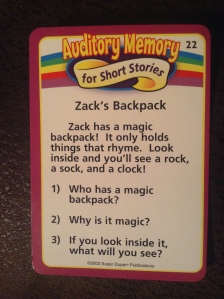When is a Language Delay a Sign of Something More?
Last week, I wrote about factors that may contribute to a language delay. (If you missed it, click here.) From that, you know that there are many things that come into play that may contribute to a child having a language delay. As discussed, some children will make progress in therapy and eventually be discharged. Other children have underlying issues going on that will require intervention for years to come.
When your child is 2 years old and you're a worried parent, how do you know when a language delay is just late talking and when is it a sign of something else?
To answer this question, let's talk about red flags. Red flags in the therapy world are characteristics that may signal an underlying condition that has not yet been identified or diagnosed. When a child has red flags, it may indicate that something else is going on other than just a delay in language. There are many red flags I could discuss, but I'll go over just a few today. Here are some things I look for when working with toddlers in speech therapy that may indicate something more than just a language delay:
-Slow to no progress in therapy: Speech therapy is usually not a quick and magical fix for most kids. Change takes place slowly over time. If a child has been in speech therapy for 6 months, then I should see some progress. The progress will look different for every child because each toddler is starting out at a different point developmentally. However, at the six month mark, a child who has made little to no progress is a red flag for me. If we started out with one word, and still have one word six months later, then that's a huge red flag. Again, it's difficult to explain what constitutes as slow versus adequate progress in therapy because all children are starting with a different set of skills. A therapist who has been in her professional for a number of years will be able to make that judgment based upon experience. Don't be afraid to ask your child's therapist if their progress seems expected or slow. But slow-no progress is a red flag.
-Difficult to engage in therapy: There are some children who after just a week or two of therapy get excited to see me and want to see what activities we will do. They plopped down on the floor and are ready to start the session. This tells me that they are socially interested in me, have discovered our routine, and desire to play with toys. These are the responses I look for after I come for home visits for a month or two.
There are a few children who don't seem to acknowledge that I am there or notice my arrival despite our weekly sessions for months. There are some children that notice me but don't care. Little to no eye contact during activities may happen as well. All of these responses are atypical. On the flip side, a child who is excited about therapy but will only sit for a minute or two despite a few months of therapy is also atypical.
When I bring up concerns about poor engagement in therapy, parents are usually quick to remind me that their child is just 2. I understand that. I also have over 10 years experience with two year olds. I know when a 2 year old is acting like a 2 year old or having a bad day versus a child who is consistently showing poor engagement. If a child is never wanting to engage with me, that's a red flag. If I have to "work" to keep their attention, that's also atypical.
-Delayed gesture development: Poor use of gestures is another red flag. If a child is not talking, then I always want to know about what types of gestures and nonverbal communication the child uses. Pointing and waving are important early gestures that toddlers need to communicate a variety of functions. Nonverbal communication like leading an adult to a desired object or bringing a cup to an adult to indicate thirst show attempts that the child is trying communicate. The fewer the gestures and nonverbal communication, the more concerned I am that something else is going on besides just a language delay.
-Poor imitation: Poor imitation comes in many forms. There can be poor word imitation, which would be expected when speech therapy first starts. Eventually though, the child should start to imitate words. There can also be poor play imitation. If I show a child how to push a train around a track, then I expect the toddler to imitate it. If a child can't imitate actions that I do, motions to songs, or play movements, then this is a red flag. Again, this is something that I don't expect immediately when therapy starts but it should come fairly soon after some intervention starts.
If I have a child on my caseload who is having red flags, then generally I will make a referral to a developmental pediatrician or speak with the child's physician. They might diagnose a child with a developmental delay, autism, or run further medical tests. If I feel the language delay may be a specific speech disorder (i.e. childhood apraxia of speech), then I may decide the child needs more intensive tests performed by me.
The most important thing a parent can do if you see some of these red flags is to ask your child's therapist about them. Open communication is key in these situations. If you are getting no where with your child's speech therapist, then talk to your child's pediatrician or get a second opinion with a different speech-language pathologist.
Therapy Thursday is for educational purposes only and not intended as therapeutic advice.












